Evy Christine – by Emily Richardson (Evy’s mom)
It was a Sunday, March 31, 2013, Easter Sunday to be precise. We had woke up to the Easter bunny visiting and sharing in family Easter time. We went to church service and came home to change into Easter ‘fun’ clothes to go to grandmas home. We lost grandpa suddenly to cancer that last summer, so this served significant as the first Easter without LaLa physically around. We were excited that MoMo (grandma) decided to continue tradition with Easter dinner and the annual egg hunt for the children. Mom, Dad, Evy and her big brother Cohen headed to MoMo’s for an afternoon of fun.
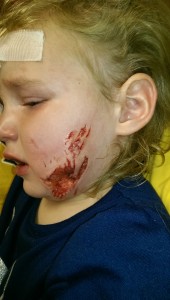 We arrived to hundreds of eggs which instantly got the children excited. Little 2 year old Evy was old enough to put eggs in her own basket and began collecting. We were casually visiting as the children gathered eggs. Evy’s uncles dog was in a dog pen, also on a tie down since he said he had been escaping lately. We noticed Evy talking to the dog, however did not see the danger. She approached the pen and placed her hands on the chain link, within seconds she began screaming and frozen in her steps. She was holding her cheek and we saw blood. I rushed and grabbed her and my husband rushed inside to grab a towel. We knew it was bad enough to go to the hospital. We put her in the car and drive 20 minutes to the nearby hospital. There they called in a plastic surgeon. We were all trying to figure out based on the injury what happened since the fence served as a barrier between the dog and Evy. Animal Control came in and we filed the report that the injury was caused by a dog. Insurance classified it as an attack. The surgeon believes based on the injury, it was either a ‘fang’ tooth that snagged and tore her cheek or a dewclaw. Either way, she required plastic surgery the next morning and ended up with 10 dissoveable stitches.
We arrived to hundreds of eggs which instantly got the children excited. Little 2 year old Evy was old enough to put eggs in her own basket and began collecting. We were casually visiting as the children gathered eggs. Evy’s uncles dog was in a dog pen, also on a tie down since he said he had been escaping lately. We noticed Evy talking to the dog, however did not see the danger. She approached the pen and placed her hands on the chain link, within seconds she began screaming and frozen in her steps. She was holding her cheek and we saw blood. I rushed and grabbed her and my husband rushed inside to grab a towel. We knew it was bad enough to go to the hospital. We put her in the car and drive 20 minutes to the nearby hospital. There they called in a plastic surgeon. We were all trying to figure out based on the injury what happened since the fence served as a barrier between the dog and Evy. Animal Control came in and we filed the report that the injury was caused by a dog. Insurance classified it as an attack. The surgeon believes based on the injury, it was either a ‘fang’ tooth that snagged and tore her cheek or a dewclaw. Either way, she required plastic surgery the next morning and ended up with 10 dissoveable stitches.
We kept our distance from the dog ever since. In fact my husbands job took us on a temporary move out of state. When we moved back home to Tennessee on October 3, 2014 everything that could have went wrong did. The truck was late, utility installation was late, etc. We foresaw a long night of unloading the truck through the night to get it unloaded without extra fees. MoMo stopped by our new home on the way home from work. She had the next day off and asked if she could take the kids for an overnight stay at her house while we worked on our own home. We saw no danger in that. After my fathers passing, she also had a new smaller home and the grandchildren had not seen it yet. They were excited to stay at MoMo’s new home. Off they went for an awesome, sugar-filled, anything goes kind of night with MoMo.
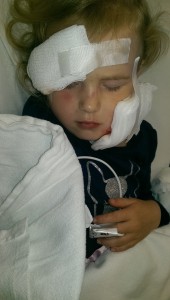 My husband and I worked all night on getting things unloaded and setting up the kids bedrooms. I got a phone call around 11am from MoMo asking how things were going. She told me she was getting them lunch and they slept great. She said she would let us sleep a little bit, but would bring them back around 1-2pm. She said their uncle Sam was getting their shoes on to go play in her fenced in back yard. I was relieved that they were experiencing a little ‘normal’ while we were in chaos. I quickly went back to unpacking.
My husband and I worked all night on getting things unloaded and setting up the kids bedrooms. I got a phone call around 11am from MoMo asking how things were going. She told me she was getting them lunch and they slept great. She said she would let us sleep a little bit, but would bring them back around 1-2pm. She said their uncle Sam was getting their shoes on to go play in her fenced in back yard. I was relieved that they were experiencing a little ‘normal’ while we were in chaos. I quickly went back to unpacking.
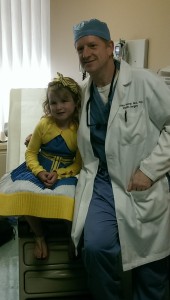 Within 30 minutes, I got a phone call and my mother, MoMo, was in complete distress and said that Cosby (unlce Brians Dog) was kept in the backyard and he has bit Evy. All she would say, “Its bad, Emily. I am so sorry. It is bad.” They were headed to their hospital. I was about 30 minutes or more away with a Dish network installation technician on my roof. I yelled to him I had to go. My husband heard me yell and asked what was going on. I was frantically searching for my keys and said ‘Evy has been bit by Cosby and it is bad. They are headed to the hospital with her.’ He had tools in hand and dropped, we left. We made it in 20 minutes. We met her brother, Cohen, outside with Uncle Sam. Sam hugged me and said, “I am so sorry, its bad.” Cohen said, “Mom, Evy has a bloody face and is in there with the doctors. The dog chewed her face.” I ran through the ER to find my 4 year old lying in a gurney, gauze taped over her right Eye, sobbing, blood stained clothing on the ground, urine smell, and holding a huge amount of gauze over her left cheek. I asked if I could see it and she removed the gauze to the horror of my eyes. This dog did not bite anything, this dog ripped my child’s face apart. I was instantly ill to my stomach and light headed. I crawled on the gurney and held my baby. I thought, “I thought she was safe. How could this happen? Why did this happen?” I began to listen to doctors guess what would happen, Animal Control coming in, MoMo telling me her story…all of it blurs. I just wanted to know how to fix my baby. We got her in light sedation and began discussing options, none of which could be completed at this hospital. We required transport to Children s Hospital.
Within 30 minutes, I got a phone call and my mother, MoMo, was in complete distress and said that Cosby (unlce Brians Dog) was kept in the backyard and he has bit Evy. All she would say, “Its bad, Emily. I am so sorry. It is bad.” They were headed to their hospital. I was about 30 minutes or more away with a Dish network installation technician on my roof. I yelled to him I had to go. My husband heard me yell and asked what was going on. I was frantically searching for my keys and said ‘Evy has been bit by Cosby and it is bad. They are headed to the hospital with her.’ He had tools in hand and dropped, we left. We made it in 20 minutes. We met her brother, Cohen, outside with Uncle Sam. Sam hugged me and said, “I am so sorry, its bad.” Cohen said, “Mom, Evy has a bloody face and is in there with the doctors. The dog chewed her face.” I ran through the ER to find my 4 year old lying in a gurney, gauze taped over her right Eye, sobbing, blood stained clothing on the ground, urine smell, and holding a huge amount of gauze over her left cheek. I asked if I could see it and she removed the gauze to the horror of my eyes. This dog did not bite anything, this dog ripped my child’s face apart. I was instantly ill to my stomach and light headed. I crawled on the gurney and held my baby. I thought, “I thought she was safe. How could this happen? Why did this happen?” I began to listen to doctors guess what would happen, Animal Control coming in, MoMo telling me her story…all of it blurs. I just wanted to know how to fix my baby. We got her in light sedation and began discussing options, none of which could be completed at this hospital. We required transport to Children s Hospital.
They arranged ambulance transport to Vanderbilt Children s Hospital. They medic team prepared me for skin graphs and the lengthy hospital stays to come. Animal Control informed me they would send someone over to get the dog, but not until tomorrow (Why not now? They said the weekend they do not have the staffing). 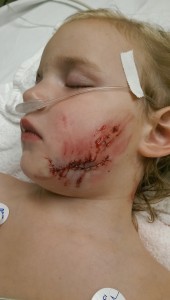 We began the 1 hour trek to the Children s Hospital. I rode in the ambulance with my sedated child, face torn to pieces, bloody and bruised and just cried. How could this have happened? I felt like a failure of a mother. We have trained our children since the could speak that our job as parents is ‘To protect them and Get them what they need’. I failed….I failed our own household motto. I did not protect my child from this monster.
We began the 1 hour trek to the Children s Hospital. I rode in the ambulance with my sedated child, face torn to pieces, bloody and bruised and just cried. How could this have happened? I felt like a failure of a mother. We have trained our children since the could speak that our job as parents is ‘To protect them and Get them what they need’. I failed….I failed our own household motto. I did not protect my child from this monster.
We arrived to the hospital. The children’s plastics and burn team were confident they could close her up. They knew it would take a lot, but they explained a large graph on the face would be worse long term. They instantly took her to the OR to get her face pieced together to the best of their ability. It was the longest 30-45 minutes of my life. She awoke a little before and just looked at me and cried. She said, ‘I Hurt’. I thought, “I know honey, I do too. I would take all of this away. This will never happen again, ever, to any child.”
After they finished and she was in recovery the doctors & surgeons came to talk to me. They told me the pattern appeared with a clean bite over the eye which should heal nicely. There was 15-25 stitches there. They told me that the dog bit and ‘shook’ her cheek and ripped through 5 layers. They found out the dog had no vaccines and it was a dirty bite. They did their best to clean it, but no guarantees. They explained based on the patterns if no one was there to stop it the next would have been her neck. My heart sank. I could not believe it, for whatever reason she was okay and I was going to take her home. Thank you God!! PTL – She was going to be okay.
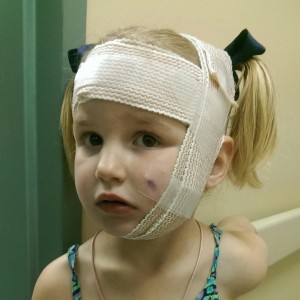 We came home within 24 hours. Within the week we noticed healing was not so great. There were green pimples forming on the surface of the injury. Turns out that was bacteria and the body trying to fight the infection pushing it to the surface. This required another surgery. She was in the hospital for 3 days monitoring the removal of the infectious pimple like things and the further infection.
We came home within 24 hours. Within the week we noticed healing was not so great. There were green pimples forming on the surface of the injury. Turns out that was bacteria and the body trying to fight the infection pushing it to the surface. This required another surgery. She was in the hospital for 3 days monitoring the removal of the infectious pimple like things and the further infection.
We watched as the cheek healed. There was a moment when it began to separate and not come together. They required a slight sedation and gluing of the injury site on the cheek. This was considered the third surgery. From that point we focused on the trauma portion. Evy had night terrors where she would wake up screaming and pee herself. This was the reaction when her attacked her and she lost bodily function. We underwent 3 months of therapy to be diagnosed PTSD. She was doing really well. We still deal with any upset she calls for MoMo as that is essentially who saved her life.
She had her first reconstruction on May 13, 2015 and it went amazingly well. She did regress into nightmares after that surgery so we are re-entering therapy which will likely come for the rest of her life. There will be many things that can trigger different things for her of that day.
4 surgeries later we have our daughter, she has a battle wound, but is still here. After each surgery, including the very first one, she woke up 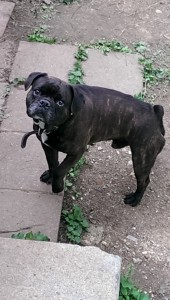 each time and asked the Recovery Nurse, ‘Am I still a princess?’. We try everyday to make sure she knows she is a princess and one of the bravest ones we know.
each time and asked the Recovery Nurse, ‘Am I still a princess?’. We try everyday to make sure she knows she is a princess and one of the bravest ones we know.
The Dog, what happened to it?
The dog was placed in a 10 day isolated quarantine where it was monitored for aggressive behavior. Since they did not find any, the dog was returned to Evys uncle, the owner, and he was charged cost of stay and charge $150 fine. He is required to put up ‘Beware of Dog’ signs and the dog is county registered as a dangerous dog. If those signs are not up, he could get fined between $5-25. We are fighting everyday to change this. We do not want dogs like these available to attack any other person and/or child.
Emily Richardson
Related article:
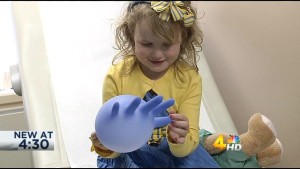 4-year-old recovering after bite from relative’s dog
4-year-old recovering after bite from relative’s dog
FRANKLIN, TN (WSMV) –
A Williamson County mother is warning other parents to be careful when allowing their children to pet unfamiliar dogs.
Read more: http://www.wsmv.com/story/29150742/4-year-old-recovering-after-bite-from-relatives-dog#ixzz3bMgOsdpi
————–
EvyChristine Richardson’s Support Page
Our daughters Story: 1st attack: March 31, 2013 We had travelled to MoMo and LaLa’s home (Grandma and Grandpas) for our annual family Easter Egg hunt. Evy was gathering Easter eggs. She was getting closer and closer to a kennel where a dog was tied down inside. She went to the fence and within minutes was screaming. Her face had broken skin. It was awful. We have no idea what exactly happened whether the dog bit, snagged or attacked. The dog was on a tie down string and the kennel fencing kept a barrier between the child and the dog. Evy was rushed the local Emergency room. Insurance instantly classified it as a dog attack. They got her cleaned and we were assigned a plastic surgeon to visit the next morning. She attended a plastic surgery consultation that placed her in surgery the very next day getting her cheek closed. She was left with approximately 20 stitches as the mark was only 2 layers deep. She did not undergo any further revisions, however we kept her out of the sun and quality of life suffered. We were cautious to avoid the dog as we did not know what had happened. On October 3, 2014 We were moving into a new home. We were thrilled to get into the coveted top school system. The truck was delayed and getting things unloaded was taxing. MoMo came to the rescues to volunteer and take the children overnight (Evy and her older Brother). We, as parents worked through the night unloading as the grandchildren went to MoMos new house and played all night. We got a phone call at 11am October 4, 2014 with MoMo in tears telling us they were playing in the back yard where they kept the dog from April 2012. The dog had bit Evy and it was bad. We dropped everything and rushed to the hospital with this pit of fear in my stomach. I expected what I had seen before, not what I saw. We were greeted by brother outside who said his sister was VERY VERY hurt. I went inside to a horror scene. My daughters face was torn apart. There was blood on her eye, cheek, exposed flesh– this was a horror film, not my sweet angel. The hospital informed me they would be getting her a transport to the Children’s Hospital as this is beyond them. They prepared me for possibilities of graphing it and the stay we would endure. We arrived at the Childrens Hospital to meet a wonderful team of plastic surgeons. There was one training on burn victims that did nothing but childs facial repair from an upstate hospital. The team went to work on my daughter and had her closed in 30 minutes! This was the best thing we could have asked for. A graph would have left discoloration, ran a larger risk of infection and required an extensive hospital stay. We were able to return home within 24 hours. Evy underwent several surgeries since then. She had to have it closed as the incision separated as it healed. She had to have a surgery to remove infection that rose from the deep tissue to the surface. She has had a total of 4 surgeries for this second injury. She had her first reconstruction on May 13, 2015. The reconstruction went amazing.
—————
Please “like” Evy Christine’s Paw Patrol on Facebook
Daxton’s Friends For Canine Education & Awareness Pug and Bulldog breed bios:
****
Pug
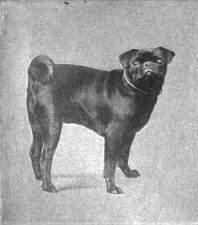 The Pug originated from Asia, most likely China, and was bred specifically to be pets for the emperor’s family. There is not much detail of their history in China and their heritage is better documented upon their arrival in Europe. During the 1500’s, Dutch traders introduced the Pug to the west. They soon became popular pets of kings and queens across Europe. They were the official dog of the House of Orange and in the Netherlands and were the personal favorite of Queen Victoria and her family and Napoleon Bonaparte’s wife, Josephine. One legend tells of a pug owned by William the Silent who barked and scratched his master to alert the Prince of Orange of the presence of assassins who were attempting to sneak into his tent.
The Pug originated from Asia, most likely China, and was bred specifically to be pets for the emperor’s family. There is not much detail of their history in China and their heritage is better documented upon their arrival in Europe. During the 1500’s, Dutch traders introduced the Pug to the west. They soon became popular pets of kings and queens across Europe. They were the official dog of the House of Orange and in the Netherlands and were the personal favorite of Queen Victoria and her family and Napoleon Bonaparte’s wife, Josephine. One legend tells of a pug owned by William the Silent who barked and scratched his master to alert the Prince of Orange of the presence of assassins who were attempting to sneak into his tent.
In 1688, it is suggested that the pug was crossed with the King Charles Spaniel to create a longer and leaner appearance. The modern Pug is much shorter and stockier than the version that became popular in Europe. It is thought that in 1860 Pugs from China were again imported and became what is now is considered today’s breed standard. During their popularity in Europe, they were depicted in paintings riding in carriages and dressed in jackets. The American Kennel Club recognized the breed in 1885. The Pug Club of America was founded in 1931. In 1981, a Pug won the Westminster Kennel Club dog show and in 2004, the Pug won the Best in Show at the World Dog Show. The Pug has made its mark in history and continues to be a favorite breed choice.
The modern Pug has a compact square body with a short-muzzle and wrinkled face and a curly, corkscrew or pig like tail. They have a smooth coat and can come in a variety of colors, but fawn or black are the most common. The fawn coloration includes a black mask. The Pug’s teeth lower teeth usually protrude further the than the upper teeth and results in what is known as an under-bite.
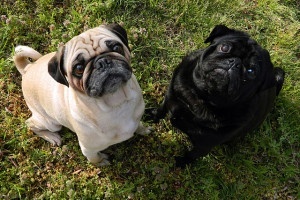 Pugs thrive in moderate climates. They have short muzzles (brachycephalic) and compact breathing airways, which results in the inability to efficiently regulate their own body temperature. Therefore, extreme caution must be taken during periods of hot weather to avoid heatstroke and breathing difficulties, which can cause death. They do not have a thick layered coat that will allow them to tolerate cold temperatures. They are a breed that will appreciate a warm jacket for the winter weather. Since they do not do well in cold or hot temperatures, it is recommended that they are not left outside for long periods of time and should always be supervised, especially in the heat. It is not recommended that Pugs ride in airplane cargo areas where temperatures cannot be properly controlled.
Pugs thrive in moderate climates. They have short muzzles (brachycephalic) and compact breathing airways, which results in the inability to efficiently regulate their own body temperature. Therefore, extreme caution must be taken during periods of hot weather to avoid heatstroke and breathing difficulties, which can cause death. They do not have a thick layered coat that will allow them to tolerate cold temperatures. They are a breed that will appreciate a warm jacket for the winter weather. Since they do not do well in cold or hot temperatures, it is recommended that they are not left outside for long periods of time and should always be supervised, especially in the heat. It is not recommended that Pugs ride in airplane cargo areas where temperatures cannot be properly controlled.
The Pug has an issue with food, they love it. They will eat until their bodies perfectly match their pig like tails. This passion for food can lead many Pugs to become over weight. Owners must manage their food intake carefully. Obesity can cause a variety of health issues in this breed. Body weight can be managed through regular daily exercise and a proper diet. Exercise should be light to avoid over exertion that can cause breathing difficulties or dangerously raise their body temperature.
Pugs have wrinkly faces, which can be cute but require medical maintenance. The wrinkles trap dirt and debris and promote the growth of yeast and bacteria. Owners of dog breeds with wrinkles must clean in between the creases on a regular basis to prevent irritation or infection.
Pugs are one of the dog breeds very susceptible to demodectic mange, also referred to as “demodex”. Demodex is caused by parasitic mites that are present on a dog’s skin. Many dogs have demodex, but do not display symptoms. Dogs with weakened immune systems can suffer from skin irritation and hair loss. A dog’s breeding line and genetics play a role in whether or not the animal will be vulnerable to demodex. Demodectic mange can be easily treated by a veterinarian.
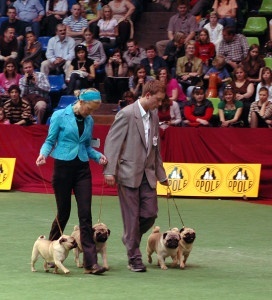 Due to their short snouts and prominent brow ridge, the Pug is prone to eye injuries. Common injuries can include proptosis, also known as eye dislocation, entropion, and cornea injuries. Caution should be taken when Pugs are at play to avoid damaging their eyes. Pugs can also experience an eye prolapse. Eye prolapses can be caused by a head or neck injury or something as simple as pulling on the leash too hard. When the eye prolapses, it leaves the socket. The eye can sometimes be pushed back into the socket by a veterinarian, but some require surgery. Many Pugs make visits to emergency veterinarians for unexpected eye injuries.
Due to their short snouts and prominent brow ridge, the Pug is prone to eye injuries. Common injuries can include proptosis, also known as eye dislocation, entropion, and cornea injuries. Caution should be taken when Pugs are at play to avoid damaging their eyes. Pugs can also experience an eye prolapse. Eye prolapses can be caused by a head or neck injury or something as simple as pulling on the leash too hard. When the eye prolapses, it leaves the socket. The eye can sometimes be pushed back into the socket by a veterinarian, but some require surgery. Many Pugs make visits to emergency veterinarians for unexpected eye injuries.
Pugs are also prone to a pharyngeal gag reflux, which is also commonly referred to as “reverse sneezing”. Reverse sneezing is usually due fluid getting trapped under their elongated palate and irritating the throat and causing breathing restriction. When excited or during leash pulling, they can gasp and snort, making a sound that does not often sound like a sneeze, but a goose. As alarming as reverse sneezing can be, it usually does not harm the dog. It can be prevented by trying to limit how excited the dog gets and by using a harness that does not put pressure on the throat or trachea. During a reverse sneezing fit, an owner can cover the dog’s nose to force it to mouth breath or massage the dog’s throat to order to try to end the fit.
Many Pugs are born with stenotic nares, which are narrow or pinched nostrils that restrict proper breathing. Stenotic nares can often put pressure on the larynx making it even more difficult for the dog to breathe. This condition can cause a Pug to pass out or temporarily lose consciousness. Some Pugs may require surgery to alleviate the breathing issues and prevent the fainting spells.
The Orthopedic Foundation for Animals has found that 64% of Pugs will suffer from hip dysplasia. They ranked the breed the second breed most highly affected by the condition. Hip dysplasia can be very painful and many dogs will require pain medication or surgery to correct the condition. Managing and treating hip dysplasia can be expensive and the surgery can have a long recovery period.
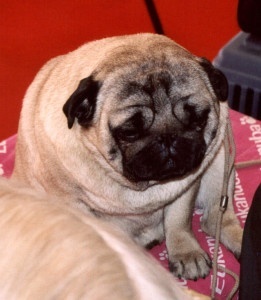 Pugs are prone to some very serious medical conditions. They can suffer from necrotizing meningoencephalitis (NME), also referred to as Pug dog encephalitis. This condition causes inflammation of the brain and meninges. Dogs can suffer from seizures, depression, blindness, ataxia, and abnormal gait. Symptoms usually emerge between 6 months and 7 years of age. There is no treatment for this fatal condition and dogs usually die 3-6 months after onset of symptoms.
Pugs are prone to some very serious medical conditions. They can suffer from necrotizing meningoencephalitis (NME), also referred to as Pug dog encephalitis. This condition causes inflammation of the brain and meninges. Dogs can suffer from seizures, depression, blindness, ataxia, and abnormal gait. Symptoms usually emerge between 6 months and 7 years of age. There is no treatment for this fatal condition and dogs usually die 3-6 months after onset of symptoms.
Another serious condition that the Pug is prone to is hemivertebrae. Hemivertebrae is what causes the curled tail in some of these dogs’ breeds. It can occur in other spinal areas it can cause a wedge or the twisting or putting pressure on the spinal cord, which can result in paralysis. Other symptoms that can occur include weakness in the back legs as well as fecal and urinary incontinence. Dogs with the condition can be treated successfully with anti-inflammatory medications or surgery. This health concern can be expensive to treat, especially if surgery is required.
The typical Pug weighs between 14-18 lbs. They have short hair and require minimal grooming. The average lifespan of the Pug is 11 years.
There has been some controversy and debate about the breeding of certain brachycephalic dog breeds due to their abundance of medical conditions. Many Pug rescues are against the breeding of Pugs and strongly believe that these medical conditions compromise their quality of life. Pug breeding is a difficult issue because the Pug’s docile personality and companion animal qualities make it a favorite for many clubs, breeders, and families. Pugs are a great example of one of the many ethical questions raised about dog breeds, should certain breeds become extinct?
In North America, from 1982-2013, Pugs have seriously attacked 1 person.
Click here to learn more about the Pug
Bulldog
The term Bulldog is most commonly referring to the English Bulldog, although there are variations in the breed, such as the American Bulldog, Olde English Bulldogge, and the French Bulldog. The original Bulldog was used in the blood sport of bull and bear baiting, until those were outlawed in 1835. In New York in the mid 17th century, the Governor brought in Bulldogs to round up wild bulls. The English and French Bulldogs (but not the other variants) were eventually crossed with a pug, and no longer have the attributes of bull baiters. The Olde English Bulldogge is a recreation of the original bull-baiting, pit-fighting bulldog of Elizabethan days and is considered one of the Pit Bull breeds. The American Bulldog is a mix of these original fighting bulldogs and a mastiff type, and is also considered a Pit Bull breed. See Section Two for information about these two Bulldog types.
Section One – The English and the French Bulldog
The English Bulldog:
The French Bulldog:
Breeders have been selectively breeding in hopes of ridding the English Bulldog of aggressive tendencies. This has led to English Bulldogs being easier to train and more likely to follow owner instructions. Despite some recent improvements of the breed, they still need strong and consistent owners. English Bulldogs enjoy limited exercise, such as daily walks, but do not need excessive exercise. Excessive exercise or heat can be detrimental to the health of an English Bulldog. Both the English and the French Bulldogs often have trouble breathing due to the short snouts and deformed palates. These canines can be far more active as puppies, but their activity will decrease as they mature.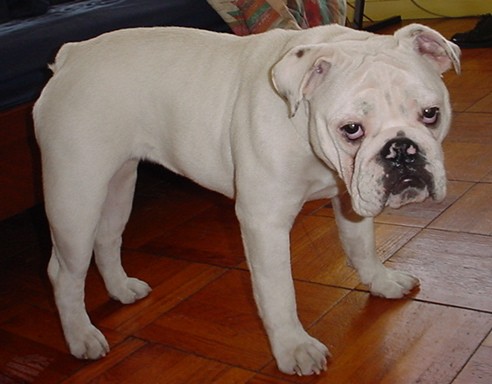
The English Bulldog is a natural guard dog and is considered to be courageous and loyal. The French Bulldog is very small, and is nowadays purely a companion dog – it is more like a Pug than like a Bulldog. English and French Bulldogs love human attention and interaction. They display a mild temperament and are generally gentle with children. However, due to the history of the bull breeds, we do recommend using extreme caution when in contact with the English Bulldog.

The English Bulldog does well with other family pets that know and understand the household rules, but may not interact in the same way with unfamiliar animals. It can show serious animal aggression. The French Bulldog can sometimes aggravate other dogs by its snorting, as if other dogs interpret the snorting to be a kind of growling. If a dog flips a French Bulldog on its back, or if it falls over during play, the French Bulldog often can’t get onto its feet again on its own due to the size and shape of its head. The French Bulldog can then suffocate if the owner doesn’t quickly turn them back upright.
English and French Bulldogs often make very loving household pets. Families that own them find them to be entertaining and comedic. English and French Bulldogs breathe heavily due to the structure of their skull and jaw. This can lead them to snort when happy and delighted. They also can be difficult to sleep with due to excessive and loud snoring. They are messy eaters and often leave behind trails of drool and slobber. Families who love the breed can easily adjust to life with an English or French Bulldog.
English and French Bulldogs do not do well in warmer climates, unless they have help keeping cool. They do not retain enough heat to be exposed to excessive cold, either. Many require regular cleaning and maintenance under the skin folds of their face and other parts of the body to prevent irritation or skin infections. Proper health maintenance on an English or French Bulldog can be time consuming and costly.
The English Bulldog’s life expectancy is short, ranging from 6 years to 10 years. They usually weigh between 40-50 pounds. Common health issues can include hip dysplasia, Patellar luxation, interdigital cysts, respiratory problems, cherry eye, and allergies. Females often require cesarean deliveries of puppies due to their small pelvis.
The French Bulldog lives about 10 years on average. They weigh between 16 – 25 pounds. Common health problems include dermatitis, various types of hemophilia, and the problems caused by the shortened snout and palate. In some lines with especially large heads, birth has to be done by cesarean section.
Section Two – The Olde English Bulldogge, The American Bulldog, The Boston Bulldog
The Olde English Bulldogge:
The American Bulldog:
Unlike the English and the French Bulldogs, the Olde English Bulldogge and the American Bulldog were not mixed with Pug or other purely companion breeds. The Olde English Bulldogge is a recreation of the original bear-baiting, horse-baiting, pit-fighting bulldog of Elizabethan England. The American Bulldog is a mix of these original bulldogs with a mastiff type1,2.
The Boston Bulldog is smaller than these two, but it is also considered a fighting breed, created by mixing Pit Bull with the Boston Terrier (the Boston Terrier is a slender terrier type that functions mostly as a companion breed)1,2. The Boston Bulldog is no longer very popular as a fighting dog because of its small size, but it retains the characteristics it was originally bred for.
All three of these Bulldogs are considered Pit Bull breeds. For more detailed information, please see our American Pit Bull Terrier page.
1. Fleig, D, Fighting Dog Breeds, THF Publications Inc, Neptune City NJ, 1996.
2. Jenkins, R and Mollett, K, The Story of the Real Bulldog, THF Publications Inc, Neptune City NJ, 1997.
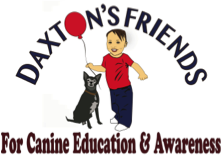
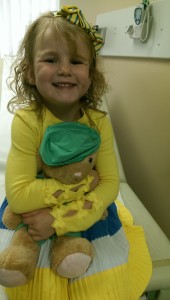
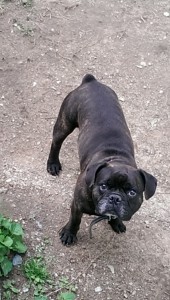
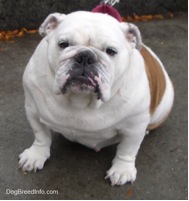
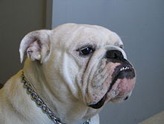
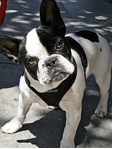
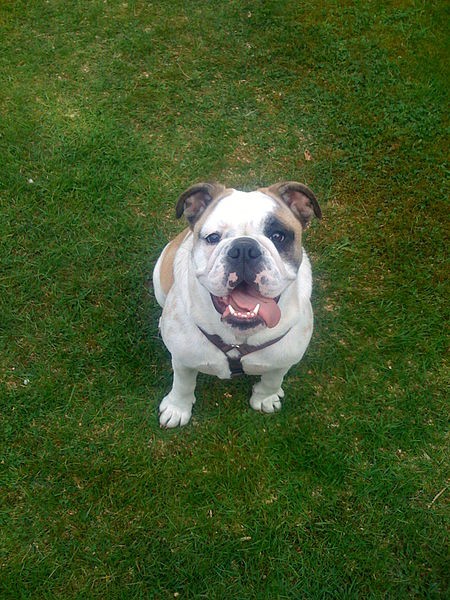

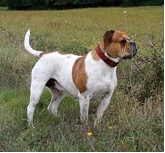
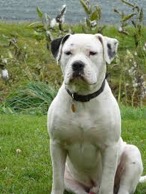
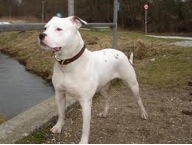
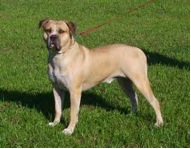
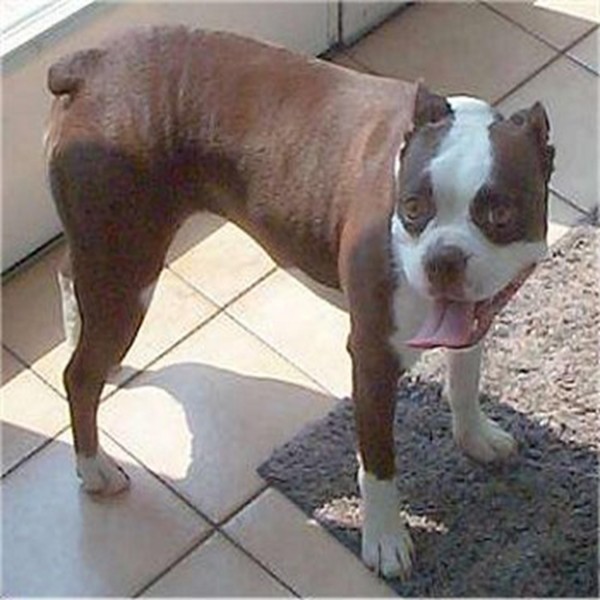
My Huskie was attacked by a English Bull dog whose owner had no control of him nor was she watching him in a dog run. I am suffering the legal fallout because the owners Bull dog apparently bit her and she turned around and said my Husky, who was in my full control and sight being held standing by my knee, bit her.
Another French Bull off-leash on a side walk attacked my dog also.
Why didn’t the uncle put the dog down? We put our registered shar-pei down for so much less! We had previously lost two shar-peis to illnesses and this one was healthy, and so sweet and wonderful to our two-year-old as well as everyone else. One day, our daughter let her slip out the door and she charged at our neighbors barking, while my husband was talking to this neighbor. My husband got her to stop and I brought her back inside. Later my husband told me that the neighbor had real fear in his eyes and told him that there were times that they were afraid to come outside when our dog was in our fence. My husband said that we can’t have our neighbors living in fear. Nor could we take any chances since this was a sign of aggression. He said that we have to put her down. I cried (and cried) and begged to try anything to work with her or find her another home. I talked to the vet, a dog trainer, and all my friends and family. I did find out that my mom had once seen two neighbor boys teasing my dog through the fence with sticks. The vet said he couldn’t tell us what to do but he relayed a similar story of a dog that was given another chance and then put a little boy in the hospital. Also, what if my older daughter and the neighbor boy were chasing the same ball? Would my dog think the boy was after my daughter and feel that she needed to protect my daughter from the neighbor boy? My dog was very good, loyal, and protective. I couldn’t live with myself if my dog seriously hurt someone! My husband told us he would take all the blame for the decision and I questioned myself for many, many years if we did the right thing. (When my oldest daughter learned about the boys teasing her dog, she was quietly angry with them for years, blaming them for having to lose her dog. And I’m not sure I would disagree.) I think putting her down was the most difficult decision in my life. Although it was and still is painful, we were trying to be responsible pet owners. That was 17 years ago.
I’m so sorry to hear about Evy’s injuries. I hope that she and the family are successful in overcoming their distress and trauma. No one is to blame. Animals are just that… animals, and therefore unpredictable. Best wishes to all of you.
I am so sorry about your babies. To this day, I am still not certain why the dogs life was/is valued above my child. In the end, It is what it is. We are still in Trauma Therapy every two weeks with Evy and her brother. We have filed an official restraining order against the dog. Thank you for your well wishes!
idiots like you should NEVER HAVE a dog . you need to be more intelligent than the animal in order to raise it properly .the fact that after realizing the cause of the aggression.instead of helping the animal recover and overcome the trauma..you kill it simply proves your absolute stupidity .you killed an animal that could have easily overcome the aggression within a week of proper training .but as long as your happy you wasted its life
I sincerely hope that you NEVER get another dog since you and your husband think their lives are so insignificant. I am totally with Robert Collins on this. Your dog could have been helped yet you never gave her the chance. What scant regard for life you have! Oh and would you have put one of your kids down for showing signs of aggression and your neighbours feared your kids because of it?